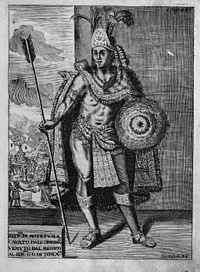- Montezuma's headdress
-
 A portrayal of Moctezuma II, with a slightly different headdress
A portrayal of Moctezuma II, with a slightly different headdress
Moctezuma's headdress is a featherwork crown (Nahuatl: quetzalāpanecayōtl) which tradition holds belonged to Moctezuma II, the Aztec emperor at the time of the Spanish Conquest. However, its provenance is uncertain,[1] and even its identity as a headdress has been questioned.[2] It is made of quetzal and other feathers mounted in a base of gold studded with precious stones. It currently rests in the Museum of Ethnology, Vienna, and is a source of dispute between Austria and Mexico, as no similar pieces remain in Mexico.
Contents
Description
The feathers of the piece have deteriorated over the centuries. It is 116 cm (46 in) high and 175 cm (69 in) across and has the form of concentric layers of different colored feathers arranged in a semicircle. The smallest is made from blue feathers of the Cotinga amabilis (xiuhtōtōtl) with small plates of gold in the shapes of half moons, inlaid with precious stones. Behind this is a layer of pink flamingo (tlāuhquechōlli) feathers, then small quetzal feathers, then a layer of white-tipped red-brown feathers of the squirrel cuckoo, Piaya cayana, with three bands of small gold plates, and finally two of 400 closely spaced quetzal tail feathers, some 55 cm (22 in) long. The quetzal feathers in the center of the headdress are raised relative to the sides. Leather straps attach the crown to the head of the wearer.
History
Although attributed to Montezuma and the Spanish conquest, the provenance of the piece is unattested, and it does not match Aztec illustrations of the headdress of their nobility. It became an object of interest to European researchers such as Ferdinand von Hochstetter and Eduard Seler at the end of the 19th century, and its identification as a quetzalapanecayotl is attributed to US American anthropologist Zelia Nuttall.[3] It was restored in 1878, while still thought to be a mantle rather than a headdress. It is attested since 1575 in the collections of Archduke Ferdinand in Ambras near Innsbruck, Austria. At the beginning of the 19th century it was deposited in the Museum of Ethnology (inventory number 10402VO) in Vienna along with other liturgical artifacts of Quetzalcoatl and Ehecatl.
References
- ^ González de Alba, Luis. "El penacho de un pobre diablo", en el periódico La Jornada, versión electrónica.
- ^ Rodríguez, Ana Mónica. "El penacho de Moctezuma es una capa de sacerdote, afirma un investigador", La Jornada, versión electrónica
- ^ Zelia Nuttall:Sur le quetzal-apanecaiotl ou coiffure Mexicaine en plumes conservée à Vienne. En: Congrès International des Américanistes, Paris 1890. Paris 1892. S. 453-459
External links
- Propuesta de trueque histórico por el Penacho
- "El penacho de Moctezuma es un atavío para la cabeza", nota de prensa emitida por el Conaculta
- "El penacho de Moctezuma es una capa de sacerdote, afirma un investigador", a letter in the journal La Jornada
- "Discutirá el Parlamento de Austria si devuelve el penacho de Moctezuma", in the journal La Jornada
- "Ve Austria difícil devolver penacho de Moctezuma", on Esmas.com
- "¿De quien es el penacho de Moctezuma?", by Carmen Cook de Leonard
- [1]
Categories:- Mexican art
- History of Mexico
- Featherwork
Wikimedia Foundation. 2010.
